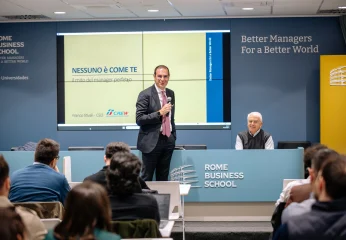The importance of being 'mobile responsive'

From simple start-ups to leaders on the market: today, companies grow by going digital and using social channels.
Today’s market space is a red ocean populated by both fledgling start-ups and companies with solid values and missions, but there are also many small and medium companies that wish to distinguish themselves from the tangle of their competitors: they are born as start-ups with the desire of becoming leaders in their field, focussed on creating their own blue ocean and avoiding the competitive free-for-all. This is called differentiation; one of the crucial aspects—together with segmentation, targeting and positioning—that Kotler, the marketing and management guru, pointed out as being fundamental to the implementation of a functional marketing strategy.
Regardless of whether or not they are competitors, the common objective of all companies is to develop incrementally—i.e., to experiment with new and more efficient means in order to reach an ever more conspicuous number of potential users and consumers. In regard to this, nowadays, social media channels represent the mouthpieces par excellence of those companies that do not settle for passively existing online and therefore just being likely to be reached by users, but evaluate the possibility of actively hunting for more and more users through digital and social media functionalities.

Today, Facebook, Twitter, Instagram, and Snapchat represent the favourite channels used by companies for their daily communication.
A research conducted by e-marketer demonstrated how Instagram’s icon-based communication has gained widespread consideration and that its visual power represents a valid line of defence of brand awareness. The chart below shows how, already in 2014, Instagram had overtaken Facebook and Twitter in terms of interaction.
Instagram has kept its pole position over the years; in fact, today, it has substantially refined its properties in order to make its visual contents ever more impactful and engaging.
The importance of being mobile responsive.
The case of Groupon
Groupon is an example of how small realities, born when the market space was free of competitors and the available tools were still very limited, have ridden the technological wave and can today claim a top positioning in the economic scenario.
Born in 2008 in United States with the idea of being a bridge between demand and supply, Groupon arrived in Italy in 2010; since then, its growth has been exponential. Specialized in selling coupons in order to enable consumers to get the services they want at lower prices, today, Groupon boasts a high sales volume and can be considered a worldwide leader in its field.
Chasing the digital evolutionary wave has been fundamental in order for Groupon to disentangle itself from the crowd of its competitors. Initially, the management of codes and coupons was manual and required very accurate work on the part of the resources, besides an incredible flexibility in their working hours; the introduction of digital tools has surely streamlined those dynamics, enabling the development of a much more methodical organization with well-defined roles. Furthermore, improvements in web screen arrangements and the fact of being mobile responsive and therefore more easily accessible by users has optimized sales volumes, enabling the attainment of a company value of one billion US dollars.
In 2010, Forbes, the American economy and finance magazine, had already predicted Groupon’s success by calling it “the fastest growing company ever”.
The Corriere della Sera case
From 1876, the year of its birth, to today, the Corriere della sera, a historic Italian newspaper, has taken considerable steps forward: it persists in its classic paper format but, in addition to its digital and mobile versions, is also present on social media networks.
The Corriere Up or C-UP is the innovative app that the Corriere has introduced in the virtual world of information with the aim of reaching its readers anywhere and at any time on their smartphones.
The structure of the app is rather articulated; it is worth noticing that it does not only submit its own articles to its readers, but also content published by other national and international newspapers (for example, the Repubblica).
Is this a counterproductive strategy?
In their book “Blue Ocean Strategy”, W.Chan Kim and Renée Mauborgne, affirmed:
[…] in order to change the strategic plan of a sector from the bottom up, it is necessary to start by shifting the focus away from the competition and placing it on the alternatives, and from sectorial clients to non-clients”.
Based upon this statement, in my opinion, the strategy adopted by the Corriere is interesting for the construction of a space of its own in the renowned blue ocean of differentiation; the readers’ focus is not shifted to other competing newspapers, but is orientated to giving them an alternative choice: competing newspapers become further sources of information and the readers will find the Corriere to be a practical and detailed source from which to draw in order to get more balanced information.
By Myriam Caccavelli
Sources:




